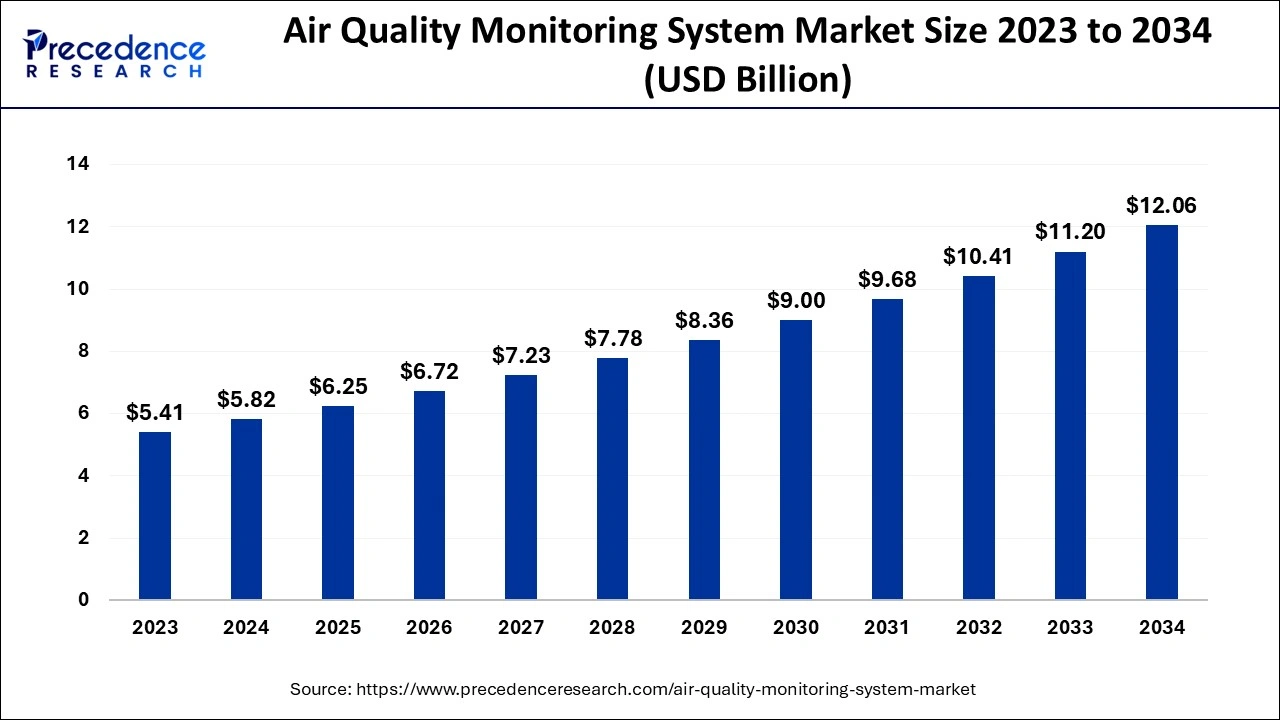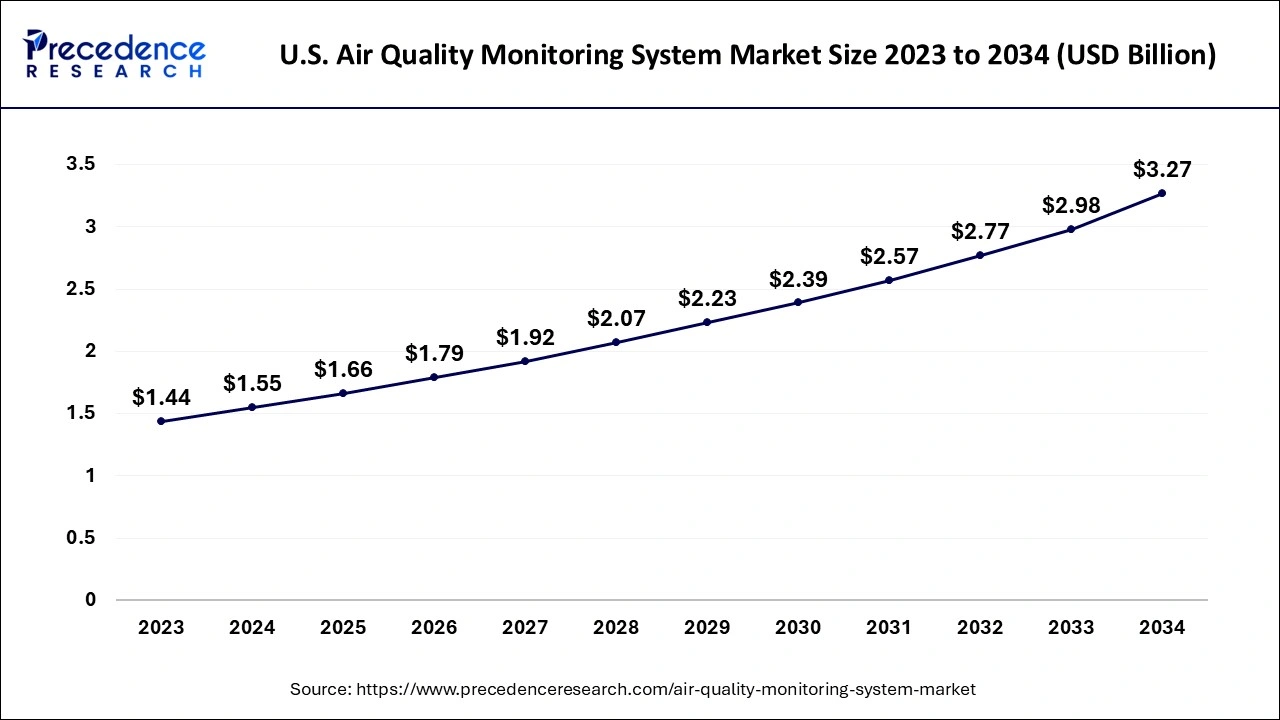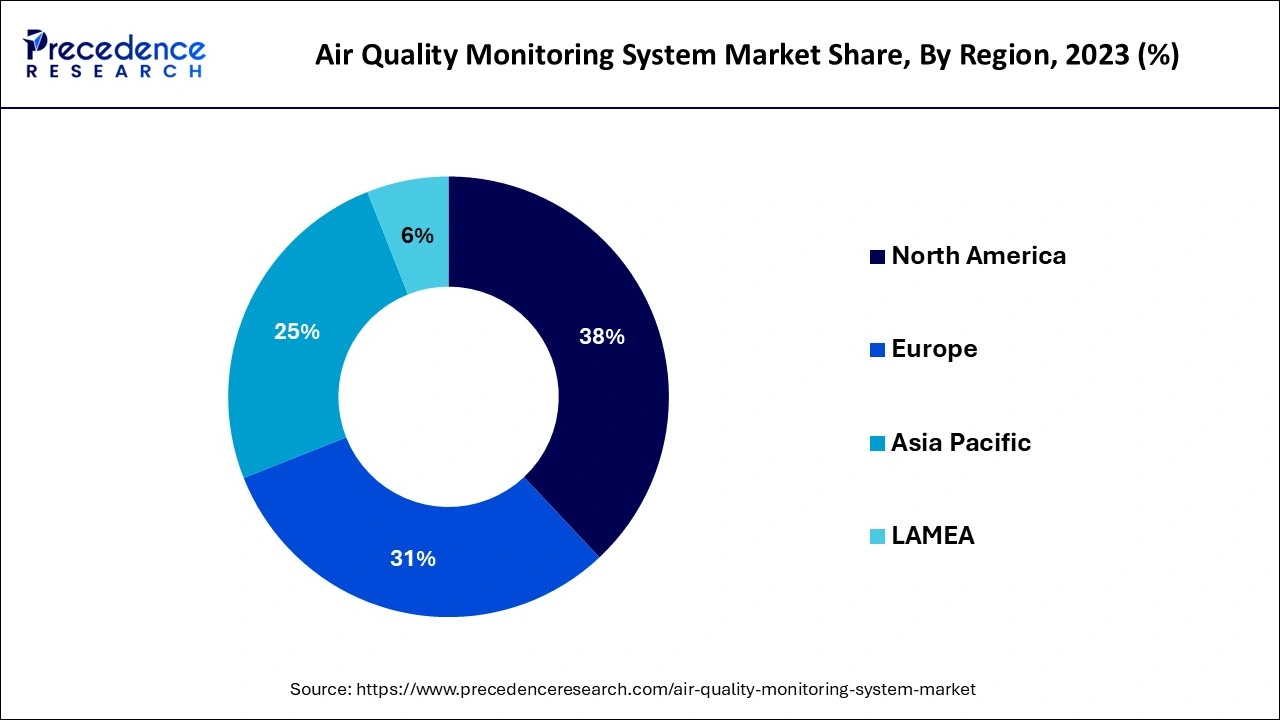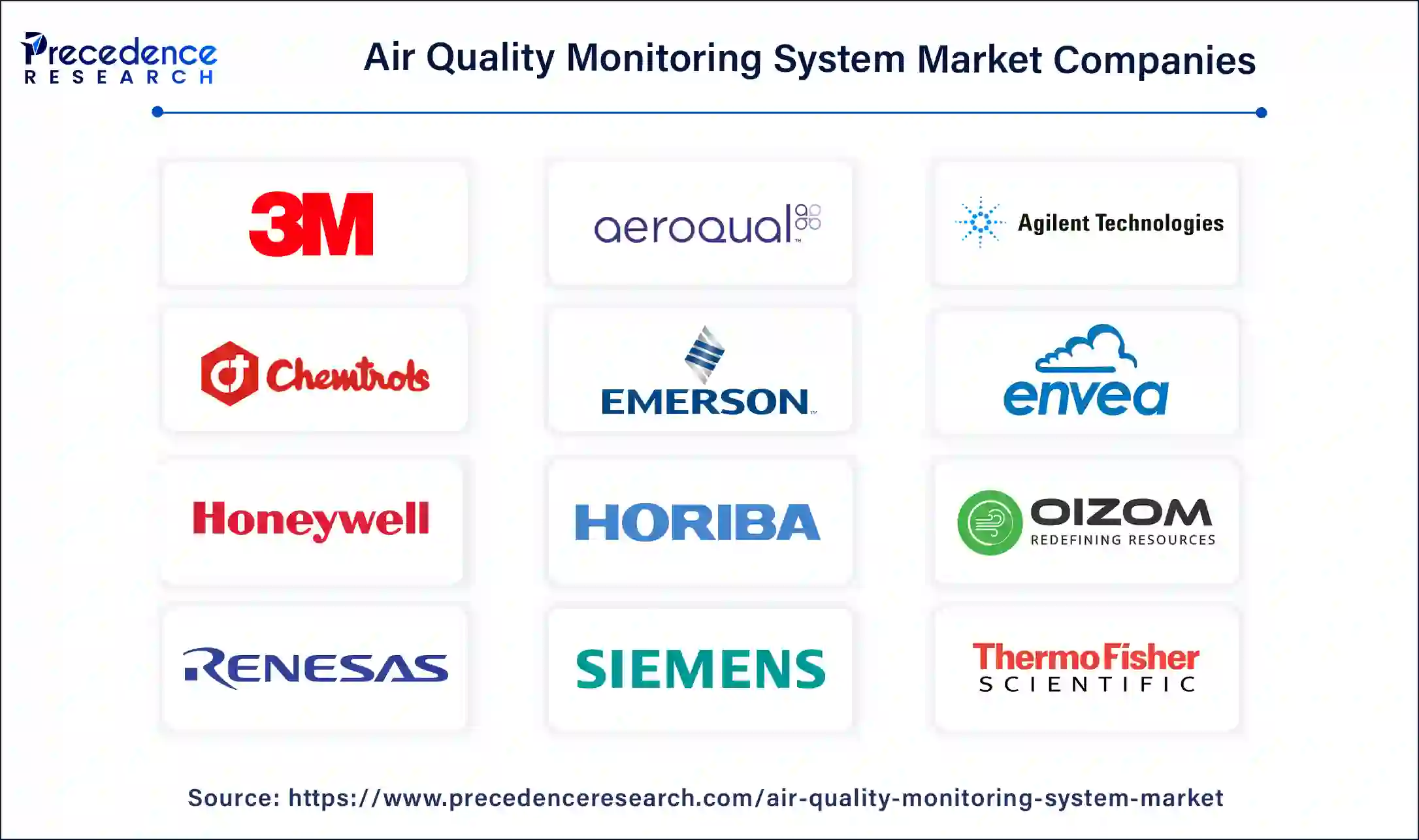March 2025
The global air quality monitoring system market size is calculated at USD 5.82 billion in 2024, grew to USD 6.25 billion in 2025 and is predicted to hit around USD 12.06 billion by 2034, expanding at a CAGR of 7.56% between 2024 and 2034. The North America air quality monitoring system market size is evaluated at USD 2.21 billion in 2024 and is expected to grow at a CAGR of 7.66% during the forecast year.
The global air quality monitoring system market size is worth around USD 5.82 billion in 2024 and is expected to hit around USD 12.06 billion by 2034, growing at a CAGR of 7.56% from 2024 to 2034. The increasing demand for collecting and measuring ambient air pollution samples to check in real-time the amount of clean and polluted air in the surrounding contributes to driving the air quality monitoring system market.

The integration of artificial intelligence, particularly machine learning, and deep learning, is revolutionizing the air quality monitoring system market. These technologies have the potential to analyze large volumes of data in real time and identify operational patterns and trends that cannot be detected using traditional methods. Machine learning and deep learning algorithms can analyze multivariate data, detect non-linear patterns, and constantly update to improve accuracy over time. The adaptation of these technologies is a regulatory necessity and also beneficial as a strategic opportunity that would result in sustainability and innovation.
The U.S. air quality monitoring system market size is exhibited at USD 1.55 billion in 2024 and is projected to be worth around USD 3.27 billion by 2034, growing at a CAGR of 7.74% from 2024 to 2034.

North America dominated the global air quality monitoring system market in 2023. The dominance of the region is attributed to the U.S. Environmental Protection Agency’s (EPA) responsibility for ambient air quality data. The air quality system stores data from over 10,000 monitors, 5.00 of which are currently active. North America follows the Clean Air Act (CAA), which is a comprehensive Federal Law that regulates all sources of air emissions. This showcases the awareness the North American government has and the actions it takes to protect its people and environment.

Asia Pacific is expected to host the fastest-growing air quality monitoring system market during the forecast period. The growth in this region is experienced due to the growing number of businesses and companies. Asia Pacific Air Quality Group, based in Singapore, is the first in Southeast Asia to distribute air quality services, including planning and consultancy, impact assessment and modeling, monitoring systems, and training. With rapid urbanization and industrialization, countries of South Asia and Southeast Asia are experiencing severe air pollution problems. The region is also focusing on Sustainable Development Goals (SDGs) linked to improving air quality, including reducing the concentration levels of PM2.5.
An air quality monitoring system is essential for improving air quality, protecting public health, and ensuring compliance with regulations. It also offers to identify pollution sources, monitor climate change, or support research and development. Six major parameters are measured in air quality monitoring for pollutants under the National Ambient Air Quality Standard: Ground-level ozone, particulate matter, carbon monoxide, lead, sulfur dioxide, and nitrogen dioxide. Along with this, there are other air toxins, such as benzene, arsenic, and mercury, which are measures to prevent cancer-causing problems.
| Report Coverage | Details |
| Market Size by 2034 | USD 12.06 Billion |
| Market Size in 2024 | USD 5.82 Billion |
| Market Size in 2025 | USD 6.25 Billion |
| Market Growth Rate from 2024 to 2034 | CAGR of 7.56% |
| Largest Market | North America |
| Base Year | 2023 |
| Forecast Period | 2024 to 2034 |
| Segments Covered | Product Type, Pollutant, Component, End-Use, and Regions |
| Regions Covered | North America, Europe, Asia-Pacific, Latin America and Middle East, and Africa |
Awareness of air pollution
Increasing awareness of the health and environmental impact of air pollution is proliferating the adoption of the air quality monitoring system market. Air pollution has become a global crisis known for its negative impacts on humans and environmental health. When polluted air is inhaled by a human, it enters the bloodstream and causes coughing or itchy eyes. The worst problems noted are respiratory problems and lung diseases, leading to hospitalization, cancer, or premature death.
There are numerous environmental effects caused by air pollution, such as acid rain, eutrophication, haze, effects on wildlife, ozone depletion, crop and forest damage, and global climate change. To limit this cause, public environmental awareness with basic tools for protection needs to be implemented in them air quality monitoring system market. The aim of this activity should be to create awareness amongst the general public and society to minimize and control pollution.
Elevated expense
The air quality monitoring system market services can be an expensive investment. The monitoring system costs between USD 15,000 to USD 40,000. Apart from the purchase cost, there is the expense of installation, equipment, and maintenance. Operating this system requires a controlled environment, regular maintenance, and proper calibration by expert technicians, which makes the cost much higher. However, this problem can be resolved by adapting to low-cost sensor systems, as reported by the World Meteorological Organization, which assesses levels of air pollution, identifies sources, and supports air quality strategies to reduce them.
Drones and UAVs
With the development of new technologies, the air quality monitoring system market is transforming the monitoring and detection of pollutants. Future advancements in the monitoring system promise to make tracking air pollution easier, more accurate, and actionable. The industry expects the incorporation of drones and UAVs (unmanned aerial vehicles). This emerging technology will help in tracking air quality in places that might be hard to reach or have limited infrastructure. By 2050, this new tool will add a flexible layer of monitoring, particularly in larger urban areas.
The outdoor air quality monitoring system segment led the air quality monitoring system market in 2023. The application of outdoor air quality monitoring systems is witnessed in the construction industry, waste management and landfill sites, port and bulk handling terminals, EIA and greenfield baseline studies, and roadside monitoring. The dominance of this region is observed due to its real-time monitoring of PM2.5 and PM10, delivering precise and reliable data that can be accessed from anywhere.
The indoor air quality monitoring system segment is predicted to witness significant growth in the air quality monitoring system market over the forecast period. This segment emphasizes tackling pollution to ensure a healthier environment. This system offers to track real-time air quality data to create a healthier indoor environment. This segment is gaining widespread attention in restaurants, hotels, universities, schools, and hospitals.
The chemical segment accounted for the largest share of the air quality monitoring system market in 2023. The dominance of this segment is due to their carcinogenic, teratogenic, or mutagenic properties which are harmful to human lives. Chemical pollutants derive from chemical factories or other activities that produce large amounts of chemical waste.
The physical segment is anticipated to grow at a significant rate in the air quality monitoring system market during the forecast period. The physical pollutants are finely divided solids or finely dispersed liquid aerosols that have exceeded the natural capacity in the environment. These particulates include soot, dust, smoke, fumes, mist, and many more.
The hardware segment contributed the largest share of the air quality monitoring system market in 2023. Hardware components in air quality monitoring systems consist of sensors, microcontrollers, and communication modules. Sensors are the predominant component in air quality monitoring systems. They measure various parameters such as particulate matter, carbon monoxide, sulfur dioxide, and nitrogen oxides. The microcontroller is the operator of monitoring systems. The data is received from the sensors, processed, and sent to the cloud server. Another hardware component is the communication module, which transmits data from the microcontroller to the cloud server through Wi-Fi, Bluetooth, or cellular networks.
The software segment is projected to grow at a notable rate in the air quality monitoring system market during the forecast period. The software components comprise a cloud platform, a mobile application, and a web-based dashboard. The cloud server is a centralized platform for storing, analyzing, and sharing air quality data. The collected data from the communication module is used to provide web and mobile applications for users to access the data.
The commercial segment recorded the highest share of the air quality monitoring system market in 2023. The dominance of this segment is observed due to its increasing focus on sustaining fresh air to acquire a sufficient level of productivity and performance during the day. Monitoring carbon dioxide and other air pollutants in air ducts and particulate matter is essential to measure indoor air quality in office buildings as the high level of CO2 presence directly leads to lower productivity of the workers or respiratory health problems. An increase in CO2 levels leads to poor decision-making, slower reaction times, and increased tiredness among employees.
The industrial segment is expected to grow at a solid CAGR in the air quality monitoring system market over the forecast period. Air pollutant parameters such as particulate matter, gases, and noise are commonly noticed in industries. Measuring these parameters using air quality monitoring systems provides real-time data and automates the operation of pollution control equipment to meet regulatory standards. It also ensures the detection of gas leakages, sudden rises in PM, noise levels, and harmful gases. The sensor generates an alert and alarm in case of immediate action.

By Product Type
By Pollutant
By Component
By End-Use
By Geography
For inquiries regarding discounts, bulk purchases, or customization requests, please contact us at sales@precedenceresearch.com
No cookie-cutter, only authentic analysis – take the 1st step to become a Precedence Research client
March 2025
December 2024
June 2024
November 2024